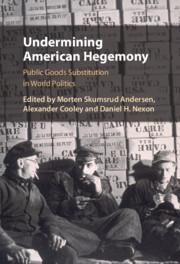150 results
Changes in anxiety and depression during the COVID-19 pandemic in the European population: A meta-analysis of changes and associations with restriction policies
-
- Journal:
- European Psychiatry / Volume 66 / Issue 1 / 2023
- Published online by Cambridge University Press:
- 26 October 2023, e87
-
- Article
-
- You have access
- Open access
- HTML
- Export citation
Review of James Woodward’s Causation with a Human Face - James Woodward, Causation with a Human Face. New York, NY: Oxford University Press (2021), 424 pp., $99.00 (hardcover).
-
- Journal:
- Philosophy of Science / Volume 90 / Issue 2 / April 2023
- Published online by Cambridge University Press:
- 25 January 2023, pp. 475-479
- Print publication:
- April 2023
-
- Article
- Export citation
Description of a clinical intervention among patients admitted to the medium secure forensic psychiatric services in Central Denmark Region
-
- Journal:
- European Psychiatry / Volume 65 / Issue S1 / June 2022
- Published online by Cambridge University Press:
- 01 September 2022, pp. S602-S603
-
- Article
-
- You have access
- Open access
- Export citation
Psychotropic drug use among children and adolescents in the Nordic countries - A systematic literature review
-
- Journal:
- European Psychiatry / Volume 65 / Issue S1 / June 2022
- Published online by Cambridge University Press:
- 01 September 2022, pp. S425-S426
-
- Article
-
- You have access
- Open access
- Export citation
Designing Long-Lasting Interior Products: Emotional Attachment, Product Positioning and Uniqueness
-
- Journal:
- Proceedings of the Design Society / Volume 2 / May 2022
- Published online by Cambridge University Press:
- 26 May 2022, pp. 961-970
-
- Article
-
- You have access
- Open access
- Export citation
Index
-
- Book:
- Undermining American Hegemony
- Published online:
- 21 July 2021
- Print publication:
- 03 June 2021, pp 218-236
-
- Chapter
- Export citation
1 - Goods Substitution and the Logics of International Order Transformation
-
-
- Book:
- Undermining American Hegemony
- Published online:
- 21 July 2021
- Print publication:
- 03 June 2021, pp 1-28
-
- Chapter
-
- You have access
- HTML
- Export citation
Contributors
-
- Book:
- Undermining American Hegemony
- Published online:
- 21 July 2021
- Print publication:
- 03 June 2021, pp viii-viii
-
- Chapter
- Export citation
Preface
-
- Book:
- Undermining American Hegemony
- Published online:
- 21 July 2021
- Print publication:
- 03 June 2021, pp ix-xi
-
- Chapter
- Export citation

Undermining American Hegemony
- Goods Substitution in World Politics
-
- Published online:
- 21 July 2021
- Print publication:
- 03 June 2021
Figures
-
- Book:
- Undermining American Hegemony
- Published online:
- 21 July 2021
- Print publication:
- 03 June 2021, pp vii-vii
-
- Chapter
- Export citation
Abbreviations
-
- Book:
- Undermining American Hegemony
- Published online:
- 21 July 2021
- Print publication:
- 03 June 2021, pp xii-xvi
-
- Chapter
- Export citation
Bibliography
-
- Book:
- Undermining American Hegemony
- Published online:
- 21 July 2021
- Print publication:
- 03 June 2021, pp 189-217
-
- Chapter
- Export citation
Contents
-
- Book:
- Undermining American Hegemony
- Published online:
- 21 July 2021
- Print publication:
- 03 June 2021, pp v-vi
-
- Chapter
- Export citation
Copyright page
-
- Book:
- Undermining American Hegemony
- Published online:
- 21 July 2021
- Print publication:
- 03 June 2021, pp iv-iv
-
- Chapter
- Export citation
Use of antipsychotics in Denmark 1997–2018: a nation-wide drug utilisation study with focus on off-label use and associated diagnoses
-
- Journal:
- Epidemiology and Psychiatric Sciences / Volume 30 / 2021
- Published online by Cambridge University Press:
- 06 April 2021, e28
-
- Article
-
- You have access
- Open access
- HTML
- Export citation
Pareto-improving transition to fully funded pensions under myopia
-
- Journal:
- Journal of Demographic Economics / Volume 87 / Issue 2 / June 2021
- Published online by Cambridge University Press:
- 02 March 2021, pp. 169-212
-
- Article
-
- You have access
- Open access
- HTML
- Export citation
Leukocyte Telomere Length Is Unrelated to Cognitive Performance Among Non-Demented and Demented Persons: An Examination of Long Life Family Study Participants
-
- Journal:
- Journal of the International Neuropsychological Society / Volume 26 / Issue 9 / October 2020
- Published online by Cambridge University Press:
- 28 April 2020, pp. 906-917
-
- Article
- Export citation
Psychiatric sequelae of minor head injury. A prospective follow-up study
-
- Journal:
- European Psychiatry / Volume 7 / Issue 4 / 1992
- Published online by Cambridge University Press:
- 16 April 2020, pp. 183-189
-
- Article
- Export citation
Aripiprazole Once-monthly is Superior to Paliperidone Palmitate in a Randomized, Head-to-head Clinical Study
-
- Journal:
- European Psychiatry / Volume 30 / Issue S1 / March 2015
- Published online by Cambridge University Press:
- 15 April 2020, p. 1
-
- Article
-
- You have access
- Export citation



